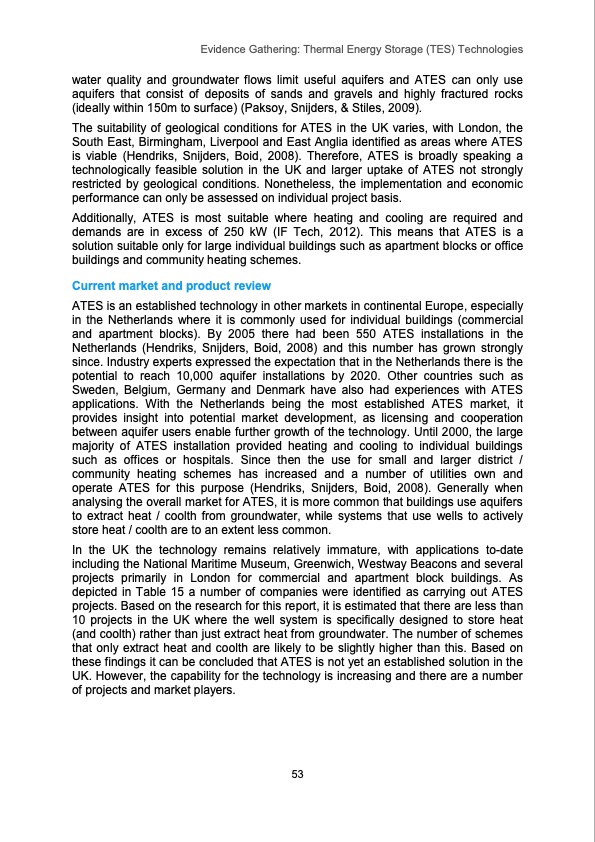
PDF Publication Title:
Text from PDF Page: 054
Evidence Gathering: Thermal Energy Storage (TES) Technologies water quality and groundwater flows limit useful aquifers and ATES can only use aquifers that consist of deposits of sands and gravels and highly fractured rocks (ideally within 150m to surface) (Paksoy, Snijders, & Stiles, 2009). The suitability of geological conditions for ATES in the UK varies, with London, the South East, Birmingham, Liverpool and East Anglia identified as areas where ATES is viable (Hendriks, Snijders, Boid, 2008). Therefore, ATES is broadly speaking a technologically feasible solution in the UK and larger uptake of ATES not strongly restricted by geological conditions. Nonetheless, the implementation and economic performance can only be assessed on individual project basis. Additionally, ATES is most suitable where heating and cooling are required and demands are in excess of 250 kW (IF Tech, 2012). This means that ATES is a solution suitable only for large individual buildings such as apartment blocks or office buildings and community heating schemes. Current market and product review ATES is an established technology in other markets in continental Europe, especially in the Netherlands where it is commonly used for individual buildings (commercial and apartment blocks). By 2005 there had been 550 ATES installations in the Netherlands (Hendriks, Snijders, Boid, 2008) and this number has grown strongly since. Industry experts expressed the expectation that in the Netherlands there is the potential to reach 10,000 aquifer installations by 2020. Other countries such as Sweden, Belgium, Germany and Denmark have also had experiences with ATES applications. With the Netherlands being the most established ATES market, it provides insight into potential market development, as licensing and cooperation between aquifer users enable further growth of the technology. Until 2000, the large majority of ATES installation provided heating and cooling to individual buildings such as offices or hospitals. Since then the use for small and larger district / community heating schemes has increased and a number of utilities own and operate ATES for this purpose (Hendriks, Snijders, Boid, 2008). Generally when analysing the overall market for ATES, it is more common that buildings use aquifers to extract heat / coolth from groundwater, while systems that use wells to actively store heat / coolth are to an extent less common. In the UK the technology remains relatively immature, with applications to-date including the National Maritime Museum, Greenwich, Westway Beacons and several projects primarily in London for commercial and apartment block buildings. As depicted in Table 15 a number of companies were identified as carrying out ATES projects. Based on the research for this report, it is estimated that there are less than 10 projects in the UK where the well system is specifically designed to store heat (and coolth) rather than just extract heat from groundwater. The number of schemes that only extract heat and coolth are likely to be slightly higher than this. Based on these findings it can be concluded that ATES is not yet an established solution in the UK. However, the capability for the technology is increasing and there are a number of projects and market players. 53PDF Image | Thermal Energy Storage (TES) Technologies

PDF Search Title:
Thermal Energy Storage (TES) TechnologiesOriginal File Name Searched:
DELTA_EE_DECC_TES_Final__1_.pdfDIY PDF Search: Google It | Yahoo | Bing
Turbine and System Plans CAD CAM: Special for this month, any plans are $10,000 for complete Cad/Cam blueprints. License is for one build. Try before you buy a production license. More Info
Waste Heat Power Technology: Organic Rankine Cycle uses waste heat to make electricity, shaft horsepower and cooling. More Info
All Turbine and System Products: Infinity Turbine ORD systems, turbine generator sets, build plans and more to use your waste heat from 30C to 100C. More Info
CO2 Phase Change Demonstrator: CO2 goes supercritical at 30 C. This is a experimental platform which you can use to demonstrate phase change with low heat. Includes integration area for small CO2 turbine, static generator, and more. This can also be used for a GTL Gas to Liquids experimental platform. More Info
Introducing the Infinity Turbine Products Infinity Turbine develops and builds systems for making power from waste heat. It also is working on innovative strategies for storing, making, and deploying energy. More Info
Need Strategy? Use our Consulting and analyst services Infinity Turbine LLC is pleased to announce its consulting and analyst services. We have worked in the renewable energy industry as a researcher, developing sales and markets, along with may inventions and innovations. More Info
Made in USA with Global Energy Millennial Web Engine These pages were made with the Global Energy Web PDF Engine using Filemaker (Claris) software.
Sand Battery Sand and Paraffin for TES Thermo Energy Storage More Info
| CONTACT TEL: 608-238-6001 Email: greg@infinityturbine.com | RSS | AMP |